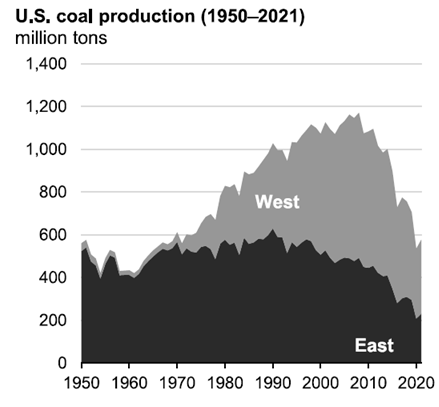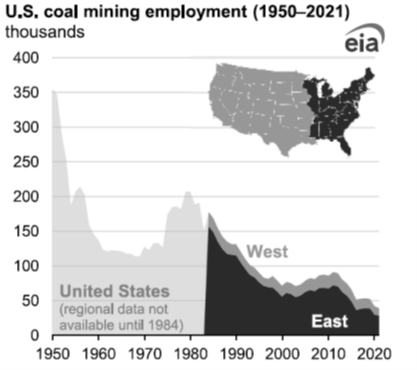Posted on February 8, 2024 by Eugene M. Trisko
Coal production and mining jobs over the past half-century have been influenced by several factors, principally demand from the utility sector, technological breakthroughs in natural gas production, railroad deregulation, and environmental regulation.
 Figure 1. Source: US DOE/EIA.
Figure 1. Source: US DOE/EIA.
The federal Clean Air Act (CAA) was enacted in 1970 and amended in 1977 and 1990. From 1970 to 1980, coal mining jobs increased rapidly due to rising electric demand and the construction of large baseload coal plants. These job gains mirrored the increase in coal production during this period (see Figure 1). Total production peaked at nearly 1.2 billion tons in 2008.
Increased coal production in the 1980s did not translate to eastern mining job increases due to the steady rise of production in low-sulfur western states, principally Wyoming. Western coal production has four times greater productivity per man hour than eastern production.
After peaking in 1950 at some 350,000 jobs (see Figure 2), coal jobs declined to a level of about 125,000 by 1970 largely due to increased mechanization of the industry – replacing pick and shovel operations with continuous mining and longwall technologies. Mining jobs then increased by nearly 100,000 jobs from 1970 to 1980 mainly due to rising electric demand and the construction of new coal generating capacity across the nation.
 Figure 2. Source: US DOE/EIA.
Figure 2. Source: US DOE/EIA.
Since 1980, coal mining jobs have declined steadily, led by decreases in eastern employment. U.S. EPA regulations under the Clean Air Act for controlling mercury, sulfur dioxide, ozone and other pollutants have contributed to the employment decline. Job losses have accelerated since 2012 with the development of low-cost fracking for natural gas. U.S. DOE has estimated that EPA’s 2012 mercury regulations accounted for the closure of some 40,000 Megawatts of coal capacity in 2015-2016 due to the high costs of controlling mercury and other toxic pollutants in older and smaller plants.
At the same time, deregulation of railroad rates in the 1980s made low-sulfur western coal competitive in many eastern markets, further eroding the market for higher-cost eastern coals.
DOE’s 2023 Annual Coal Report indicates that total U.S. coal mining employment had declined to a level of 43,582 jobs in 2022, with 32,090 jobs east of the Mississippi River and 11,434 jobs west of the Mississippi.
Compared with the 1980 peak of some 200,000 mining jobs, recent coal mining employment has declined by more than 150,000 jobs, with job losses concentrated in the East. Further losses are in store due to EPA’s proposed carbon guidelines for coal and natural gas plants. The Biden Administration is seeking to virtually eliminate conventional coal generation by 2030, with only a handful of plants projected to utilize carbon capture and storage technology.
With many utilities now proposing to defer retirements of existing coal plants due to reliability concerns, it remains to be seen whether these optimistic goals can be met while preserving electric system resilience and reliability. The build-out of renewable energy and electric storage capacity is simply not keeping pace with the rate of baseload fossil generation retirements.